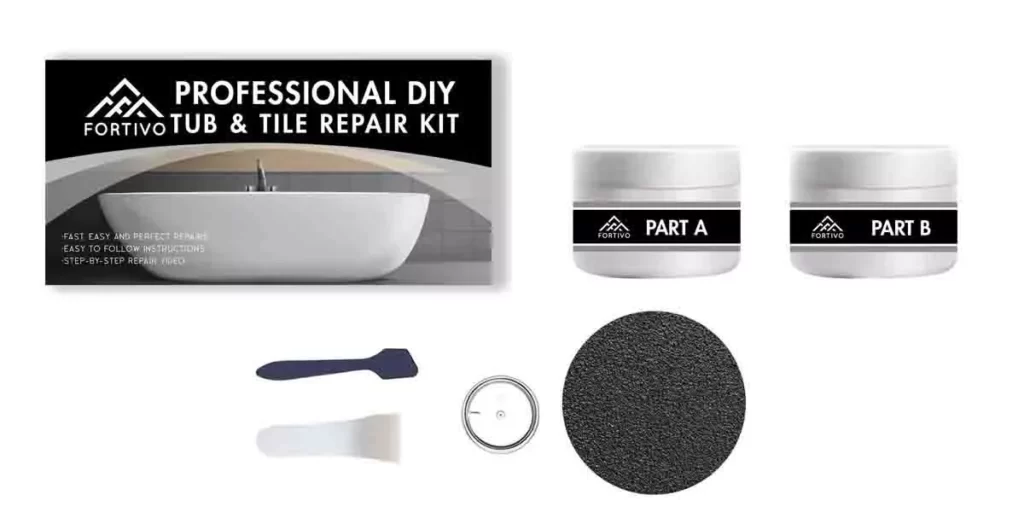A cracked bathtub is not a fun or comfortable experience. It can make you feel unsafe and cause you to worry about safety. It’s wise to temporarily fix the cracks in a bathtub to avoid a worsening situation.
While researching fixes for a cracked bathtub, you might have come across something called Flex Seal. In short, Flex Seal is a water-based sealant coating used for DIY purposes around the home for sealing holes and cracks.
The most common question people ask Will Flex Seal Fix A Cracked Bathtub?
The straightforward answer is Yes. Flex Seal works great on Fiberglass tubs, but porcelain and ceramic tubs will not seal well to them, and your crack may only be sealed for a few days. You should consider Flex Seal as a temporary solution.
In this blog post, we’ll discuss step by step how to fix a cracked bathtub using Flex Seal. The process will be straightforward, so don’t hesitate to give it a try if your bathtub has cracks.
You Might Like:
- 6 Alternatives to Caulking Around the Bathtub (Must-Try!)
- 4 Temporary Fixes For Cracked Bathtub (Must-Try!)
- 7 Tips On How to Remove Old Bathtub Sticker Residue
What Is Flex Seal & How It Works?
Flex Seal is a sealant that is used to fix hard-to-repair cracks, leaks, holes, and other surface damage. It comes in various colors and can be used on many different characters, such as concrete, masonry, vinyl flooring, or porcelain tile.
Flex Seal bonds to the material it’s applied to. It seals holes and cracks with a chemical reaction that creates an invisible layer of flexible polyurethane rubber. The best part is you can resume your daily activities immediately after it dries & cures.
Will Flex Seal Fix A Cracked Bathtub?
In most cases, you can use Flex Seal as a temporary solution to repair cracks and chips in your bathtub. The liquid seeps into cracks and dries into a flexible, rubberized coating that stops water from leaking out. For better results, apply Flex Tape on the crack before coating with Flex Seal Liquid Spray.
Here’s how to do it:
How to Use Flex Seal to Fix A Cracked Bathtub?
Things You’ll Need:
- Flex Seal spray rubber sealant coating
- Rubberized waterproof flex tape
- Old towel or rag
- Fine-grit sandpaper
Step 1 – Clean the Surface thoroughly
The first step is to set up a clean work area. It will be easier and less messy if you use an old towel or rag to wipe down the bathtub. Or use fine-grit sandpaper to rub the area.
Step 2 – Apply Flex Tape Over Damaged Area
Open the Flex tape. Cut it into strips, long enough to cover the crack. Apply it over the crack. And give it 10 minutes to cure.
In this step, you’re patching the crack with flex tape to prevent leaks from the bathtub. Since the patch is easily noticeable, you’ll lose the original aesthetics of the bathtub.
Step 3 – Coat the Area With Flex Seal Spray
Once the patch cures, now it’s time for the Flex Seal to do its job.
Shake the can for a minute before use. With Flex Patch On, Start coating the area by spraying Flex Seal Rubber Sealant. It will seal out moisture, air, and other contaminants.
Pro-Tip
You should spray a larger area than the leak area and feather the edges. It is best to apply multiple coats rather than one thick coat, and use above 60 degrees Fahrenheit. Apply additional coats if light can pass through.
Step 4 – Leave It For 24 Hours
Allow the layer to dry for 24-48 hours before filling your bathtub with water.
Step 5 – Check For Any Water Leakage
To check if everything is working fine, fill your tub with water. Use a temporary marker to mark your current water level in the tub. Leave it for an hour and come back to see if the water reduced below the marked level. If you don’t notice any difference, you’re good to go.
In case of leakage, you may need to apply some additional layers to it.
Here’s a video that helps you in the Flex Seal application:
Alternatives to Flex Seal for Repairing Bathtub Cracks
Bathtub Repairing Kit
Repair kits for bathtubs are inexpensive and fairly easy-to-use ways to fix cracks. The best part is, a homeowner can easily handle the application process without the help of a plumber or contractor. I’ve used the product below, and had great results:
A bathtub repair kit can effectively repair any cracks, holes, scratches, marks, chips, or dents in a bathtub. The kit consists of two repair compounds (known as Part A & B) which are mixed and applied to the damaged area. Then, left for hours to cure. I cover this process in my post on How To Fix Cracks In A Plastic Bathtub here.
I recommend using Fortivo’s tub repair kit since it works on most tub materials, including acrylic, porcelain, enamel, and fiberglass.
Epoxy Resin Glue
Using Epoxy Resin Glue is another effective way to mend cracks in bathtubs, ceramic tiles, metal pipes, and many other household items. Because Epoxy Resin offers high durability and flexibility, you can consider it one of the best glues for repairing your bathtub.

The process of using epoxy resin glue to repair a cracked bathtub is quite simple.
- First, you need to clean the crack with a degreaser or soap and water mixture.
- Next, use a putty knife or scraper to fill up all of the cracks with epoxy resin adhesive until it begins to show on the other side of the crack.
- Allow this adhesive time to dry & cure.
After 24 hours, fill the bathtub with water and check if there is any leakage. Since Epoxy Resin Glue is resistant to moisture and water, you’ll barely notice any leakage. If it does, apply a few more layers of Epoxy Resin.
Recommended | 4 Temporary Fixes For Cracked Bathtub (Must-Try!)
Wrap Up
Summing up, Flex Seal might not be the best, but it does benefit in fixing bathtub cracks to some extent and can be treated as a temporary fix. For an effective solution, you can consider using a bathtub repairing kit, an inexpensive option to mend cracks, chips, holes, scratches, etc., as well as maintain your bathtub’s aesthetics at the same time.
Explore More On Fixing Bathtub





